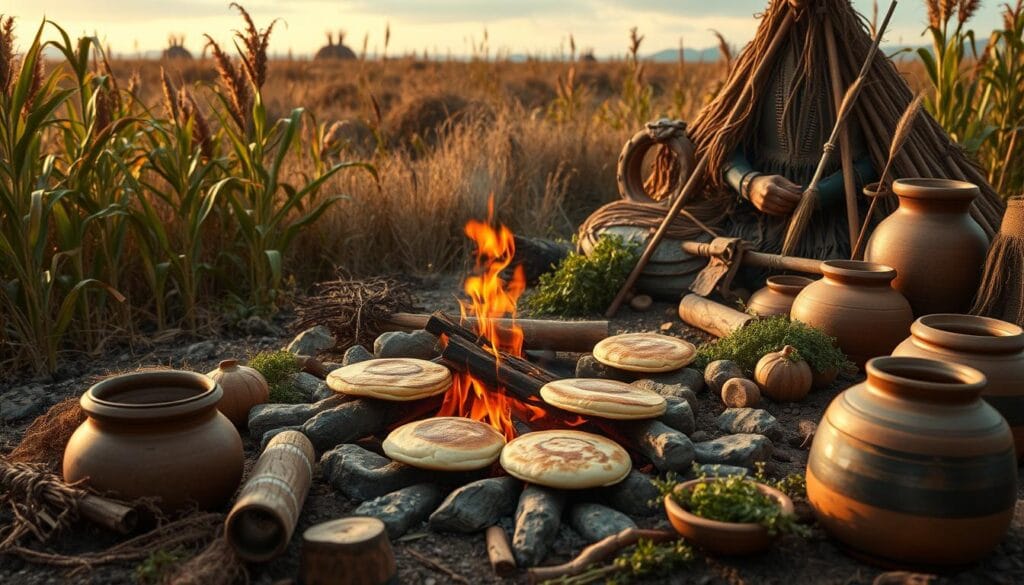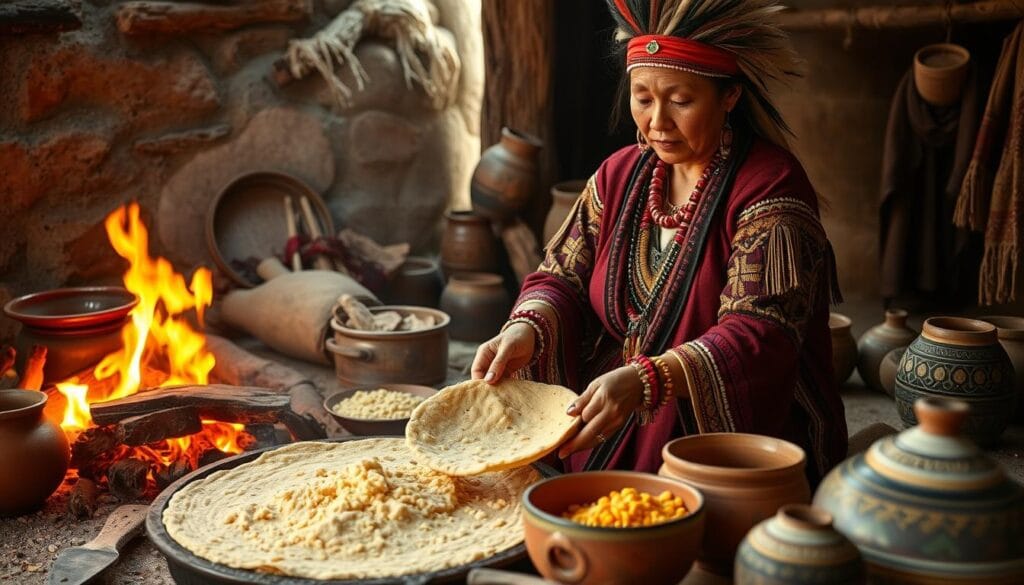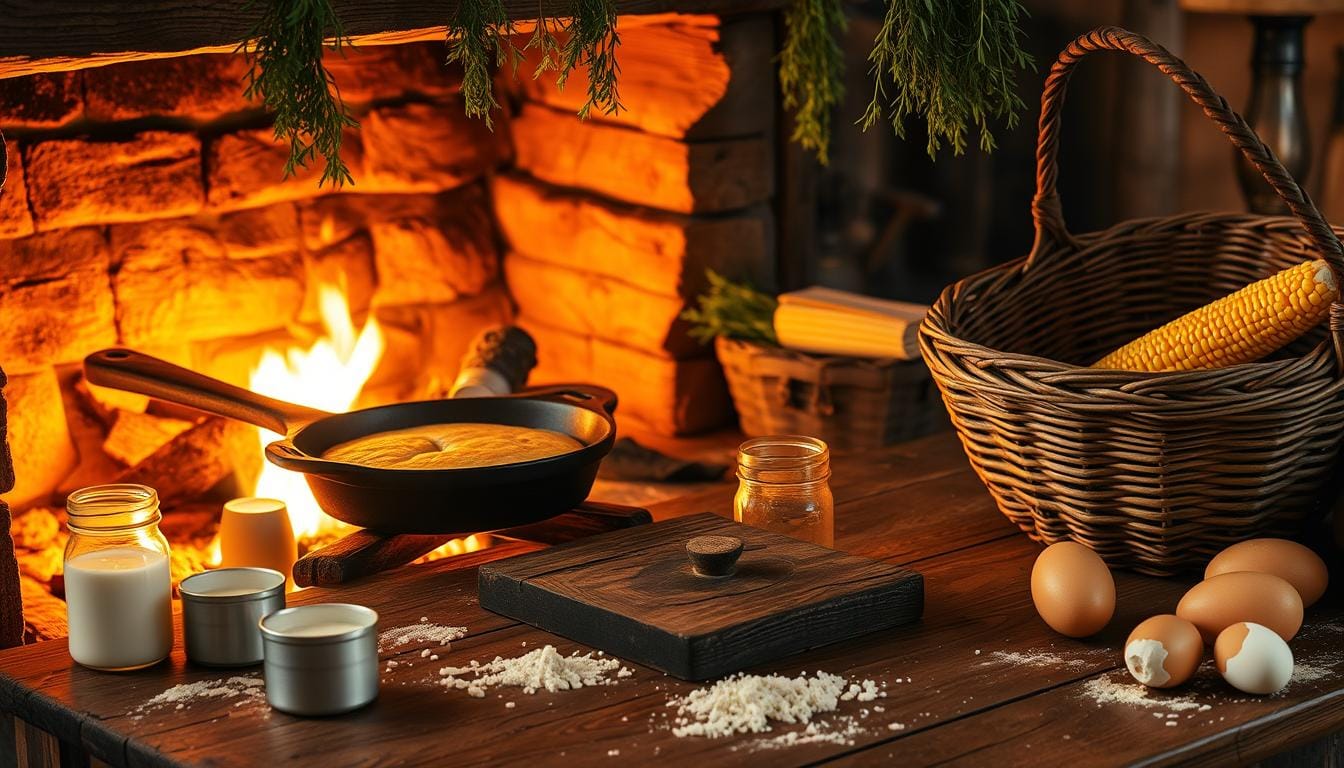Imagine sitting at your grandmother’s kitchen table. She’s making golden, crispy Johnny cakes, which tell a story older than the United States itself.
The origin of johnny cakes is a culinary mystery. It goes through Native American traditions, colonial kitchens, and regional cooking techniques.
These simple cornmeal flatbreads have been a part of American cuisine for centuries. Their name sparks curiosity among food historians. Why are they called johnny cakes? The answer is complex, involving indigenous cooking, linguistic evolution, and cultural exchange.
Johnny cakes have traveled from Rhode Island to South Carolina’s kitchens. They’ve adapted and changed over time. Yet, they’ve kept their simplicity. Their history shows the resilience and creativity of early American cooks.
Key Takeaways
- Johnny cakes have roots in Native American culinary traditions
- The earliest written record dates back to 1739 in South Carolina
- Multiple theories exist about the origin of their unique name
- Johnny cakes represent a versatile food with regional variations
- The dish reflects early American cultural and culinary adaptability
The Origins and Etymology of Johnny Cakes
The story of johnny cakes is rooted in Native American traditions. It shows how cultures and languages mixed between indigenous peoples and early settlers.

The history of johnnycake is complex and spans centuries. Historians have found many theories about its origins.
The Shawnee Connection
One theory says johnny cakes were first called Shawnee cakes by the Pawtuxet Indians. English settlers might have changed this name to “johnny cake” over time.
Early Written Records from 1739
The first written mention of “johnny cake” was in 1739 in South Carolina. This record is key to understanding the term’s early use in America.
- First recorded in 1739 in South Carolina
- Potentially derived from Shawnee tribal terminology
- Represents a linguistic adaptation of indigenous food culture
The Jonakin Theory
Another theory links the name to “jannock,” used in Northern England in the 16th century. “Jonakin” appeared in New England in 1765, showing a possible connection.
The evolution of “johnny cake” reflects the dynamic cultural interactions between Native Americans and European settlers in early America.
These theories show the deep cultural background of this cornmeal bread. They show how language and food tell a story of American history.
Native American Roots and Cultural Significance
The history of cornmeal flatbread starts with Native Americans. They turned corn into a key part of their food. For centuries, corn was a mainstay in their diet, making up about 80% of their nutrition.

Native Americans used special ways to prepare corn. They ground dried corn into meal, creating johnnycakes. This showed their skill in preserving food and understanding nutrition.
*Corn was more than just food – it was a way of life for Native American communities.*
Johnnycakes meant more than just food. They connected people to farming traditions. They also shared cultural knowledge and were easy to make.
- A connection to agricultural traditions
- A method of preserving and sharing cultural knowledge
- A versatile food that could be prepared quickly and easily
- A nutritionally dense meal rich in complex carbohydrates
When Europeans came, Native Americans taught them about food. This was a big moment in American food history. Almost 60% of early recipes used Native American methods and ingredients.
Johnnycakes were very nutritious. They had about 10% dietary fiber and important minerals like iron and magnesium. They were also gluten-free, showing Native American cooking’s creativity.
Why Are They Called Johnny Cakes: Exploring Different Name Theories
The history of johnny cakes is rich and varied. Many theories explain why they are called johnny cakes. These cornmeal flatbreads have a long history, with many names and stories.
Food historians have long been curious about the johnnycake name. Let’s explore the most interesting theories about these American flatbreads.
Journey Cake Evolution
“Johnny cakes” might come from “journey cakes”. These were great for travelers. They were durable and nutritious, perfect for long trips.
- Earliest recorded use of “journey cake” dates back to 1775
- Designed as compact, long-lasting food for travelers
- Easy to prepare with minimal ingredients
Regional Name Variations
In different places, these cornmeal treats have many names. Each name shows the local cooking traditions:
- Hoecakes – Popular in Southern United States
- Shawnee cakes – Reflecting Native American influences
- Spider cornbread – A unique regional variation
“Every region tells a story through its food names” – Anonymous Culinary Historian
The story of johnny cakes shows how food names capture cultural and historical journeys. It’s a tale of America’s culinary evolution.
Traditional Rhode Island Johnny Cakes
Rhode Island johnny cakes are a beloved part of New England’s food scene. The Samuel E. Perry Grist Mill has been making these since 1703. It’s a key part of Rhode Island’s food culture.
The South County-style johnnycakes are special. They’re made by pouring boiling water over a mix of cornmeal, sugar, and salt. This method is precise and unique.
“The batter should be sturdy yet thin enough to slip off a spoon, similar to buttery mashed potatoes.” – Bob Smith, Perry Grist Mill
Key Characteristics of Authentic Rhode Island Johnnycakes
- Use of fine white corn ground by water process
- Thickness not exceeding 1/4 inch when cooked
- Cooking time of 5-6 minutes per batch
- Cooked using traditional bacon drippings for flavor
| Ingredient | Quantity |
|---|---|
| White Cornmeal | 1 cup |
| Salt | 3/4 teaspoon |
| Water | 1 cup |
| Milk | 1/2 cup |
The Perry Grist Mill is special. It’s the only mill in Rhode Island that can call its product jonnycake without the “h”. This shows its commitment to keeping traditional recipes alive.
For those who love food and history, Rhode Island johnny cakes are more than a meal. They connect us to the region’s rich culinary past.
The Essential Ingredients and Preparation Methods
Making authentic New England johnnycake needs a deep understanding of cornmeal flatbread history. You must also know the right culinary techniques. Your journey starts with picking the best ingredients and learning traditional cooking methods.
Cornmeal Selection and Quality
The key to a great johnny cake is its cornmeal. Old recipes call for high-quality flint corn, finely ground. When picking cornmeal, remember these important points:
- Choose stone-ground flint corn for authentic flavor
- Look for local, freshly milled cornmeal
- Avoid overly processed commercial varieties
Traditional Cooking Techniques
Making johnny cakes is more than just mixing ingredients. You need to aim for the perfect texture and flavor:
- Mix 3 cups of cornmeal with boiling water
- Add 1 teaspoon of salt for enhanced taste
- Create a smooth, pourable batter
- Cook on a hot griddle or skillet
“A true johnny cake is a testament to simplicity and tradition in New England cuisine.”
Cooking at the right temperature is key. Aim for a medium-hot surface of 375-400 degrees Fahrenheit. Cook each side for about 2-3 minutes until golden brown. This makes a crisp outside and a soft inside.
Your johnny cakes will make 8-10 delicious flatbreads. Each one captures the spirit of traditional New England cooking.
Historical Significance in Early American Cuisine
Johnny cakes were key for early American settlers. They were a lifeline during tough times, like the westward expansion and the American Civil War. These cornmeal flatbreads came from Native American traditions, showing the importance of survival cooking.
“A meal that could feed an entire family with minimal ingredients was worth its weight in gold for pioneers.” – Historical Food Researcher
On the Oregon Trail, johnnycakes were a vital food for travelers. The recipe was simple yet packed with nutrition. It usually had:
- 1 cup of cornmeal
- 3 teaspoons of granulated sugar
- 1/2 teaspoon of salt
- 2 tablespoons of butter
- 2 1/2 cups of boiled water
Johnny cakes were loved during the American Civil War. They were cheap and easy to make. Cornbread became a favorite, enjoyed in many ways, from fluffy loaves to quick patties.
| Time Period | Significance of Johnny Cakes |
|---|---|
| Mid-1800s | Primary food for Oregon Trail pioneers |
| Civil War Era | Affordable and versatile food for soldiers |
| Late 19th Century | Staple in developing American cuisine |
The legacy of johnny cakes goes beyond just food. They show the resourcefulness and adaptability of early settlers. They turned simple cornmeal into a meal that fed generations.
Regional Variations Across New England
New England’s rich culinary scene offers many takes on the beloved rhode island johnny cakes. Each state adds its own flavor to this traditional cornmeal flatbread. This creates a colorful mix of tastes and cooking methods.
The story of the new england johnnycake shows how different each region is. These cornmeal treats have changed to match local tastes and what’s available.
Rhode Island Style: The Gold Standard
Rhode Island is known for its special way of making johnny cakes. They use finely ground white cornmeal, water, and a bit of salt. This makes a thin, crisp flatbread that honors its Native American origins.
- White cornmeal preferred
- Minimal ingredients
- Thin, crisp texture
State-by-State Variations
| State | Johnny Cake Characteristics |
|---|---|
| Massachusetts | Thicker texture, often includes eggs |
| Connecticut | Sweeter version, sometimes adding sugar |
| Vermont | Rustic style, using stone-ground cornmeal |
Modern Culinary Adaptations
Today, chefs have updated the classic rhode island johnny cakes. They add butter, eggs, and baking soda. This makes the traditional flatbread more like a pancake.
“The beauty of johnny cakes lies in their adaptability – a testament to culinary creativity.” – Local New England Chef
Whether you like the old-fashioned thin crisp or the new, fluffy version, new england johnnycakes are a hit. They bring joy to food lovers all over the region.
The Evolution from Native American Flatbread to Modern Day
The journey of the native american johnnycake is a fascinating story. It shows how Indigenous food traditions have evolved. From simple cornmeal flatbread to a dish loved by many, johnny cakes have changed yet stayed true to their roots.
Early Native American communities made these flatbreads with just cornmeal and water. They were perfect for traveling, earning names like “journey cakes” for their flexibility.
“The subtle sweetness and rich texture of johnny cakes position them as an energy-boosting snack suitable for various occasions.”
- Original recipes used only corn meal and water
- European settlers gradually introduced new ingredients
- African American cooking traditions further influenced preparation
- Modern variations include butter, milk, and wheat flour
As different cultures mixed, johnny cakes went from a survival food to a soul food in Southern cuisine. Places like Rhode Island made them thin and crispy with white cornmeal. Meanwhile, the South preferred thicker, more hearty versions.
Now, johnny cakes are more than food. They tell a story of adaptation, resilience, and creativity. They connect Indigenous traditions to today’s dining experiences.
Johnny Cakes in Caribbean and International Cuisine
Johnny cakes have traveled far from their cornmeal roots. They are now loved in many places. These flatbreads have changed but kept their core.
In the Caribbean, johnny cakes show off amazing diversity. Islands like the Bahamas and Jamaica add their own spin to this cornmeal bread.
Caribbean Culinary Traditions
Caribbean johnny cakes have their own special flavors. In Antigua, they’re a key part of breakfast. They’re made with local ingredients and cooking methods.
- Traditional breakfast companion
- Served with mature cheese
- Used as a dipping bread for soups and stews
Global Adaptations
Johnny cakes have inspired dishes worldwide. Countries like Belize and Colombia have made their own versions.
| Region | Unique Characteristic |
|---|---|
| Bahamas | Flour and sugar enhanced recipe |
| Jamaica | Thicker, more substantial preparation |
| Dominican Republic | Served with various savory accompaniments |
Johnny cakes are quick to make, taking about 30 minutes. They make 6 servings. They’re also great for vegans and inspire creativity.
“From Native American roots to international kitchens, johnny cakes represent a delicious culinary journey.” – Culinary Historian
These flatbreads are enjoyed everywhere, from the Caribbean to North America. They bring people together through food.
Famous Historical Figures and Their Connection to Johnny Cakes
Johnny cakes have a special place in American history. They were loved by many influential people. Benjamin Franklin, a Founding Father, thought they were “better than a Yorkshire muffin.” This shows how much he enjoyed their taste and cultural value.
The story of johnny cakes starts with early American settlers. But they became more than just food. The Marquis de Lafayette, a key figure in the American Revolution, loved them during his visits to Rhode Island. His love for them shows how johnny cakes brought people together, crossing social and cultural lines.
“A simple food that tells the story of a nation’s culinary heritage” – Anonymous Food Historian
Notable Connections to Johnny Cakes
- Benjamin Franklin’s culinary endorsement
- Marquis de Lafayette’s regional appreciation
- Early American political and social significance
Johnny cakes are more than just bread. They symbolize a food for everyone, bridging social gaps. They show the resourcefulness of early American cooking. From presidential tables to revolutionary fighters, johnny cakes represent American ingenuity and tradition.
The question of why they’re called johnny cakes is answered by American culture. These cornmeal cakes brought people together, making them a key part of culinary history.
Cultural Impact and Modern Popularity
New England johnnycake recipes have grown from simple beginnings to a cherished tradition. They are now loved by food lovers all over the United States. These cornmeal flatbreads have changed from Native American basics to modern treats that celebrate local creativity and heritage.
The love for Rhode Island johnny cakes today shows a strong bond to old cooking ways. Chefs and home cooks mix up traditional recipes, adding new twists while keeping the dish’s true spirit.
- Culinary adaptations now include additional ingredients like butter, eggs, and baking soda
- Regional variations highlight local ingredient preferences
- Restaurants feature johnny cakes as a nostalgic tribute to early American cuisine
In New England, especially in Rhode Island, johnny cakes mean more than just food. They stand for community heritage and a long-standing culinary tradition.
| Region | Johnny Cake Characteristics |
|---|---|
| Rhode Island | Traditional thin, crispy cornmeal flatbread |
| Southern States | Thicker, more pancake-like texture |
| Caribbean | Flour-based, fried variations |
Today’s chefs keep making new england johnnycake recipes fresh, keeping this historic dish alive in today’s food world. From fancy restaurants to cozy diners, johnny cakes link us to America’s rich food history.
“Johnny cakes are not just a food, they’re a living piece of American culinary heritage” – Local Rhode Island Chef
Conclusion
The story of why they are called johnny cakes is more than just a food tale. It spans centuries of American history, from Native American roots to Caribbean twists. These cornmeal flatbreads weave a rich cultural and culinary heritage.
The journey of johnny cakes is one of survival and cultural exchange. What started as a basic food for Native Americans has become a favorite dish across North America. Enjoyed in Rhode Island, Jamaica, and Belize, these cakes unite people through their culinary roots.
Exploring johnny cakes shows how a simple recipe holds deep cultural meaning. They link to “journey cakes” and early American cuisine, symbolizing resilience and creativity. Each bite shares a story of adaptation, survival, and human connection through food.
When you enjoy these cornmeal cakes, you’re part of a long tradition. You’re not just eating a simple dish, but celebrating a culinary heritage that has fed generations. Johnny cakes are a delicious reminder of the power of simple, resourceful cooking.
FAQ
What exactly are johnny cakes?
Johnny cakes are traditional flatbreads made from cornmeal. They come from Native American cultures and were a key food in early America. They mix ground cornmeal, water, and sometimes salt. Then, they’re cooked on a griddle to make a simple, versatile bread.
Why are they called johnny cakes?
There are a few theories about the name. Some say it comes from “Shawnee cake,” named after a Native American tribe. Others think it’s from “journey cake” because of its portability. Or it might come from “jannock,” meaning genuine or true in some dialects.
Are johnny cakes the same as hoecakes?
Similar but not the same, they have regional differences. Hoecakes are more common in the South and might have different ingredients. Johnny cakes are famous in New England, especially in Rhode Island.
What type of cornmeal is best for making johnny cakes?
Flint corn is the best for authentic johnny cakes. Rhode Island-style uses finely ground cornmeal. This makes a thin, crispy flatbread with a unique flavor.
How do Rhode Island johnny cakes differ from other regional variations?
Rhode Island johnny cakes are very thin and crispy. They use local flint cornmeal. They are thinner and crisper than other versions and are a local culinary treasure.
Are johnny cakes only an American food?
While they started in North America, johnny cakes have spread to the Caribbean and beyond. Different places have made their own versions, like the Bahamian johnny cake, which includes flour and sugar.
What historical significance do johnny cakes have?
Johnny cakes were vital in early American history. They were cheap and easy to carry, making them important during hard times like the American Civil War. They were a key food for both Native Americans and European settlers.
Can johnny cakes be made with modern adaptations?
Yes, today’s chefs and home cooks have made many new versions. They add things like butter, eggs, and leavening agents. This makes them more like pancakes but keeps the traditional cornmeal base.

